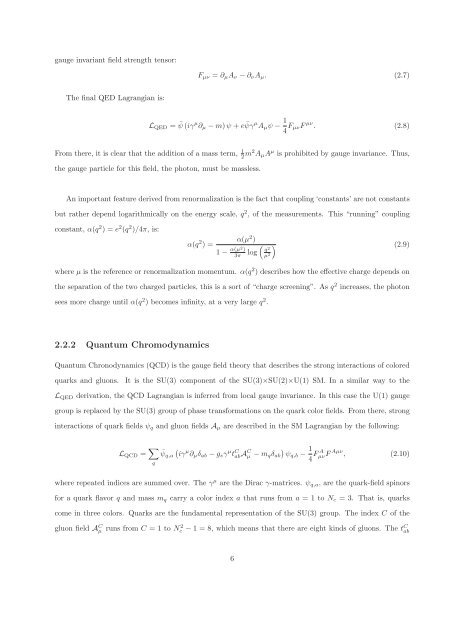CERN-THESIS-2012-153 26/07/2012 - CERN Document Server
CERN-THESIS-2012-153 26/07/2012 - CERN Document Server
CERN-THESIS-2012-153 26/07/2012 - CERN Document Server
You also want an ePaper? Increase the reach of your titles
YUMPU automatically turns print PDFs into web optimized ePapers that Google loves.
gauge invariant field strength tensor:<br />
The final QED Lagrangian is:<br />
Fµν = ∂µAν − ∂νAµ. (2.7)<br />
LQED = ¯ ψ (iγ µ ∂µ − m)ψ + e ¯ ψγ µ Aµψ − 1<br />
4 FµνF µν . (2.8)<br />
From there, it is clear that the addition of a mass term, 1<br />
2 m2 AµA µ is prohibited by gauge invariance. Thus,<br />
the gauge particle for this field, the photon, must be massless.<br />
An important feature derived from renormalization is the fact that coupling ‘constants’ are not constants<br />
but rather depend logarithmically on the energy scale, q 2 , of the measurements. This “running” coupling<br />
constant, α(q 2 ) = e 2 (q 2 )/4π, is:<br />
α(q 2 ) =<br />
α(µ 2 )<br />
1 − α(µ2 )<br />
3π log<br />
<br />
q2 µ 2<br />
(2.9)<br />
where µ is the reference or renormalization momentum. α(q 2 ) describes how the effective charge depends on<br />
the separation of the two charged particles, this is a sort of “charge screening”. As q 2 increases, the photon<br />
sees more charge until α(q 2 ) becomes infinity, at a very large q 2 .<br />
2.2.2 Quantum Chromodynamics<br />
Quantum Chronodynamics (QCD) is the gauge field theory that describes the strong interactions of colored<br />
quarks and gluons. It is the SU(3) component of the SU(3)×SU(2)×U(1) SM. In a similar way to the<br />
LQED derivation, the QCD Lagrangian is inferred from local gauge invariance. In this case the U(1) gauge<br />
group is replaced by the SU(3) group of phase transformations on the quark color fields. From there, strong<br />
interactions of quark fields ψq and gluon fields Aµ are described in the SM Lagrangian by the following:<br />
LQCD = <br />
q<br />
<br />
¯ψq,a<br />
µ<br />
iγ ∂µδab − gsγ µ t C abA C <br />
µ − mqδab ψq,b − 1<br />
4 F A µνF Aµν , (2.10)<br />
where repeated indices are summed over. The γ µ are the Dirac γ-matrices. ψq,a, are the quark-field spinors<br />
for a quark flavor q and mass mq carry a color index a that runs from a = 1 to Nc = 3. That is, quarks<br />
come in three colors. Quarks are the fundamental representation of the SU(3) group. The index C of the<br />
gluon field A C µ runs from C = 1 to N 2 c − 1 = 8, which means that there are eight kinds of gluons. The t C ab<br />
6















